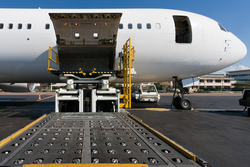Air cargo equipment - restraint straps
Published date: |
|
Modified date: |
|

The safety of a cargo hold has long been the subject of debate. It’s sometimes imagined that the cargo hold is a very inhospitable and dangerous place, but should not be the case. On the contrary, the space is ventilated and heated - after all, animals including pets often fly in this space. It has even been known for baggage handlers to fall asleep in the cargo hold and spend an unplanned flight there – it’s not recommended, but not dangerous. Cabin crew even have bunks in the hold for long-haul flights.
Jet manufacturer Airbus even proposed that cargo holds could be converted into flying hotels, in the ultimate Airbnb experience with proposals including the creation of useful spaces such as a conference suite, medical zone, or kids’ play room. Whilst these are exciting possibilities for the future, the current use of cargo holds for traditional purposes always seem to create an air of mystery and worry – particularly for the safety of our pets during flight.
How is cargo kept safe in the hold?
It is of vital importance that cargo can be loaded quickly and securely onto planes. Cargo containers are one way of achieving this. In other settings cargo is secured using straps.To ensure the straps used are reliable and suited to their purpose, BS ISO 16049-2:2020 Air cargo equipment - restraint straps - Part 2 - Utilization requirements and recommendations and lashing calculations has been published.
The international standard sets out general utilization requirements, recommendations and calculation methods to guarantee effectiveness and ultimate load strength of tie down and lashing arrangements used to restrain cargo on civil aircraft.
The standard covers cargo loaded onto pallets restrained onto a cargo deck, additional tie-downs when required due to pallet maximum gross mass, non-unitized individual pieces of cargo on an unrestrained pallet, and individual pieces on non-containerized baggage or cargo compartments.
Why freight rules the skies
We think of cargo as something added to passenger planes, but freight planes are a huge feature of aviation. In the US, FedEx operates its own airline, FedEx Express, to transport 15.7 billion tonne-kilometres per year using 691 aircraft. That’s twice the fleet of Ryanair, which is Europe’s largest airline.
These freight planes work to a tight schedule; cargo is loaded in containers formed to fit the curved interior of the plane, rolled into place and fastened. So, it’s important that the restraint straps used are as up to standard as possible for the safety of the cargo, crew and passengers.
What kind of straps does the standard relate to?
The standard covers the use of straps conforming to ISO 16049-1, for example steel cables, rope and other types of straps. The use of chains, rods or other rigid devices is beyond the scope of the document.
The standard sets out guidance on spacing cargo, angling straps and methods for arranging restraint straps. It provides calculation principles and advice on issues such as cargo slippage, risk of tilting and operator responsibilities.
The standard, which was revised and published in January 2020, is available from the online BSI shop.
Click here to provide feedback

